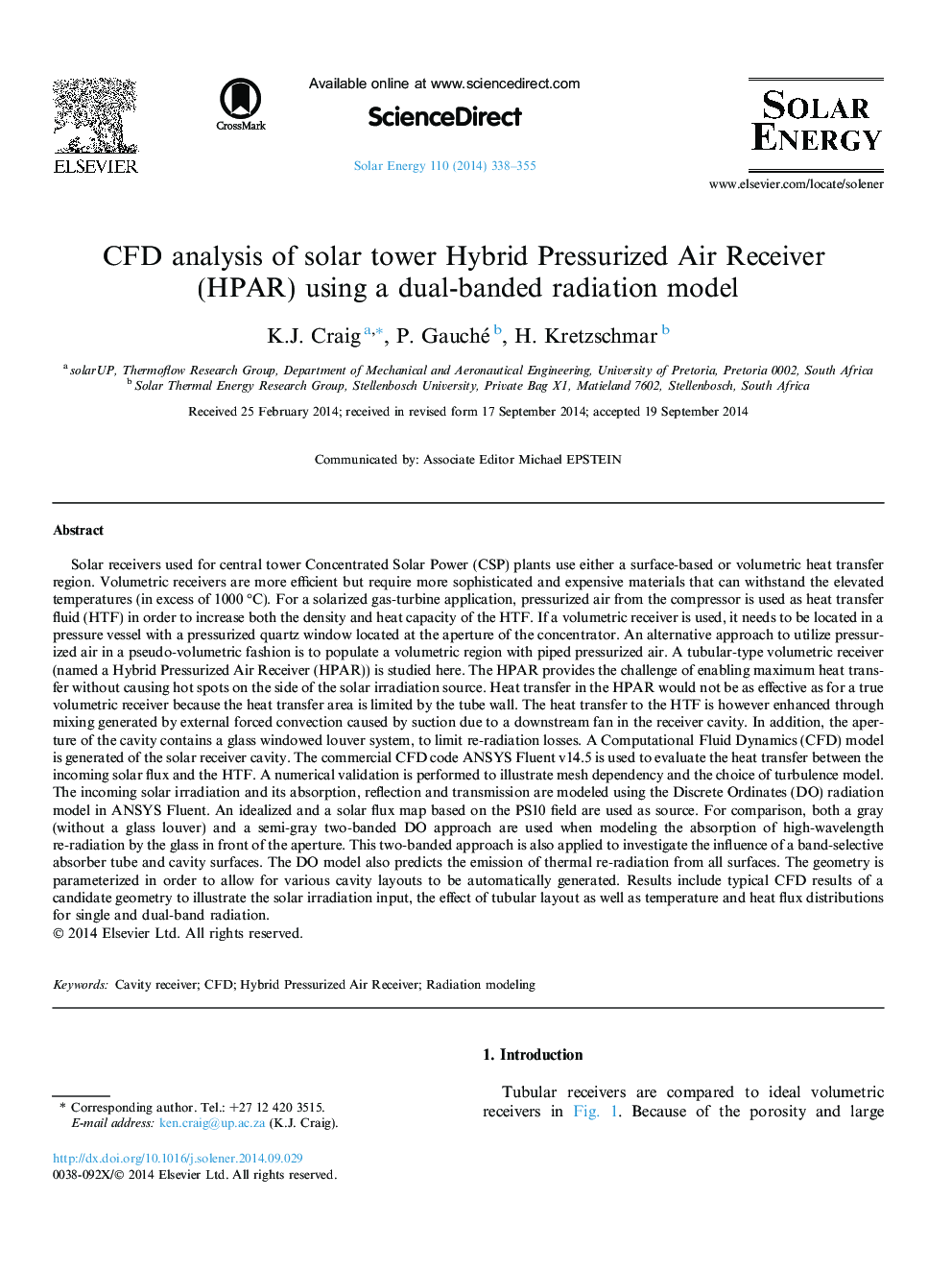| کد مقاله | کد نشریه | سال انتشار | مقاله انگلیسی | نسخه تمام متن |
|---|---|---|---|---|
| 7938188 | 1513108 | 2014 | 18 صفحه PDF | دانلود رایگان |
عنوان انگلیسی مقاله ISI
CFD analysis of solar tower Hybrid Pressurized Air Receiver (HPAR) using a dual-banded radiation model
دانلود مقاله + سفارش ترجمه
دانلود مقاله ISI انگلیسی
رایگان برای ایرانیان
موضوعات مرتبط
مهندسی و علوم پایه
مهندسی انرژی
انرژی های تجدید پذیر، توسعه پایدار و محیط زیست
پیش نمایش صفحه اول مقاله

چکیده انگلیسی
Solar receivers used for central tower Concentrated Solar Power (CSP) plants use either a surface-based or volumetric heat transfer region. Volumetric receivers are more efficient but require more sophisticated and expensive materials that can withstand the elevated temperatures (in excess of 1000 °C). For a solarized gas-turbine application, pressurized air from the compressor is used as heat transfer fluid (HTF) in order to increase both the density and heat capacity of the HTF. If a volumetric receiver is used, it needs to be located in a pressure vessel with a pressurized quartz window located at the aperture of the concentrator. An alternative approach to utilize pressurized air in a pseudo-volumetric fashion is to populate a volumetric region with piped pressurized air. A tubular-type volumetric receiver (named a Hybrid Pressurized Air Receiver (HPAR)) is studied here. The HPAR provides the challenge of enabling maximum heat transfer without causing hot spots on the side of the solar irradiation source. Heat transfer in the HPAR would not be as effective as for a true volumetric receiver because the heat transfer area is limited by the tube wall. The heat transfer to the HTF is however enhanced through mixing generated by external forced convection caused by suction due to a downstream fan in the receiver cavity. In addition, the aperture of the cavity contains a glass windowed louver system, to limit re-radiation losses. A Computational Fluid Dynamics (CFD) model is generated of the solar receiver cavity. The commercial CFD code ANSYS Fluent v14.5 is used to evaluate the heat transfer between the incoming solar flux and the HTF. A numerical validation is performed to illustrate mesh dependency and the choice of turbulence model. The incoming solar irradiation and its absorption, reflection and transmission are modeled using the Discrete Ordinates (DO) radiation model in ANSYS Fluent. An idealized and a solar flux map based on the PS10 field are used as source. For comparison, both a gray (without a glass louver) and a semi-gray two-banded DO approach are used when modeling the absorption of high-wavelength re-radiation by the glass in front of the aperture. This two-banded approach is also applied to investigate the influence of a band-selective absorber tube and cavity surfaces. The DO model also predicts the emission of thermal re-radiation from all surfaces. The geometry is parameterized in order to allow for various cavity layouts to be automatically generated. Results include typical CFD results of a candidate geometry to illustrate the solar irradiation input, the effect of tubular layout as well as temperature and heat flux distributions for single and dual-band radiation.
ناشر
Database: Elsevier - ScienceDirect (ساینس دایرکت)
Journal: Solar Energy - Volume 110, December 2014, Pages 338-355
Journal: Solar Energy - Volume 110, December 2014, Pages 338-355
نویسندگان
K.J. Craig, P. Gauché, H. Kretzschmar,